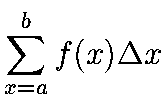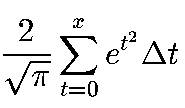
For this assignment, you will write a C program called erf.c that computes and prints a table for the error function, erf(x).
The error function is used in diffusion theory, statistics, and neural networks research. It is the result of finding the area under the curve of a particular exponential function. It can be expressed as an integral like this:

 in increments of delta-x.
in increments of delta-x.
This means that the integral from a to b of a function f becomes closer and closer to the sum of the function evaluated at intervals between a and b in multiples of delta-x as delta-x gets closer and closer to zero. So if we choose a very small value, like 0.00001, for delta-x, then
 in increments of delta-x
in increments of delta-x
 in increments of delta-t
in increments of delta-t
Your job is to write a program that asks the user to enter a step, then prints a table giving the error function from x=0 through 2 in increments of the user's step. You must use the sum shown above to calculate the error function, so you will have nested loops: the outer one for counting through x, and the inner one for approximating the error function. The table should include both value for x and for erf(x). Here is an example output of the program; yours should look similar. If the user enters a step of 0.1, the table should look like this:
x erf (x) ------ ------ 0.0000 0.0000 0.1000 0.1132 0.2000 0.2288 0.3000 0.3491 0.4000 0.4767 0.5000 0.6151 0.6000 0.7680 0.7000 0.9404 0.8000 1.1388 0.9000 1.3717 1.0000 1.6506 1.1000 1.9914 1.2000 2.4162 1.3000 2.9564 1.4000 3.6574 1.5000 4.5853 1.6000 5.8385 1.7000 7.5652 1.8000 9.9926 1.9000 13.4740 2.0000 18.5679You can use a for loop for both the inner and outer loop. I recommend first making your program approximate the error function for a single value of x, as we did in class, and then wrapping another for loop around that to print the table for various values of x.
Pi is approximately 3.14159265358979323844. You can find the square root of a float or double in C using the sqrt function, e.g., a = sqrt (b); . You must first include math.h the way you do stdio.h. You can find e raised to a power with the exp function, also in math.h, e.g. a = exp (b); . There's no "squared" function in C, but you can just multiply a number by itself to get the same effect. Important: when using the math library functions from math.h, you must link in the math library when compiling. Compile your program like this:
cc -o erf erf.c -lmThe -lm tells the compiler to link in the math library. Also if you forget to put #include <math.h> in your program, your program might compile but it will not work correctly.
Your program should work on the main system. Make sure to comment the variables and important statements in the program. To turn in your program, e-mail a copy of your C file to the teaching assistant from your account as before.
This assignment is due at midnight on Thursday, March 19, 2009. You will be writing this program completely from scratch; make sure you understand how to do it and ask the instructor any questions you have well before it is due.